Ls Andre Malraux the Voices of Silence Art History or Philosophy
Should Art have a Purpose?
"Art for art's sake is an empty phrase. Art for the sake of truth, art for the sake of the good and the beautiful, that is the organized religion I am searching for (Ratcliffe, 2011, p.29)." This phrase from Victorian writer George Sand was a response to the trend in the romantic era to celebrate art that does not have or demand a purpose. It is a rendering in English of l'art pour 50'art, a phrase coined past philosopher Victor Cousin (Encyclopædia Britannica, 1999). This thought continued well into the 20th century and became the basis for formalism, although in recent years the conventionalities that art must have a purpose and an artist must justify what they do has get prevalent. And so does fine art really need a purpose, and what exactly exercise we mean by purpose?
To empathise this idea 1 must go back prior to the 1800s, when artists were not costless as such and required patronage by wealthy people to produce artworks that were specifically deputed. Art in those days was created specifically to serve a function. A lot of artworks were religious in nature as the most bachelor commissions were the ornament of churches (Bohn & Saslow, 2012, p.65).
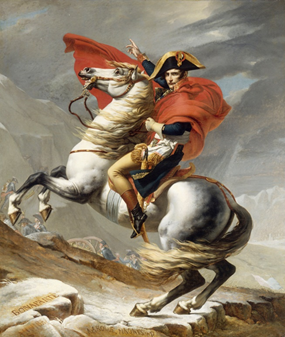
Portraits of important people were as well beingness produced, every bit they were another mutual commission. These were often heavily embellished to make the bailiwick appear more powerful, or bonny that they actually were, leading sometimes to blatant fabrication of details. Jacques-Louis David'southward Bonaparte Crossing the M Saint-Bernard Pass (Figure 1) is a good example of this.
Napoleon is pictured leading his troops across the Alps astride a bucking horse. Unperturbed, he confidently points the style. In reality, he did not lead his troops beyond the Alps but followed them up the adjacent twenty-four hours on a donkey. He as well never posed for the painting. David used a sketch of his head and modelled the body on that of his son climbing a ladder (Cunningham et al., 2016, p.640).

By the 1800s artists started to adopt a new epitome of existence independent and figures of greatness. Photography would eventually brand mere reproduction easier and freed art to exist more than expressive, and the rise of industry led to the inflow of the Romantic Motility, which was characterised by a deepened appreciation of the dazzler of nature and an adoration of emotion over reason and intellect (Encyclopædia Britannica, 2019).
Walter Pater, one of the foremost art critics of the era, disseminated the belief that art should provide sensual pleasance rather than convey a meaning or message, an ideology that inspired painters like Whistler and even writers such every bit Oscar Wilde (Nunokawa & Sickels, 2005, p.5). He wrote in the decision of his well-nigh successful volume The Renaissance, that "To burn always with this hard, precious stone-like flame, to maintain this ecstasy, is success in life" (Pater, 1928, p.221), an idea he developed further in the aptly-named Marius the Epicurean. He goes on to push "the love of fine art for its ain sake" (Pater, 1928, p.223).
In dissimilarity to Pater's view, John Ruskin and later advocates of socialist realism believed that art should serve a moral or didactic purpose. Ruskin declared that "the entire vitality of art depends upon its being either full of truth, or full of use" (Ruskin, 1996, p.140).
Caspar David Friedrich was a painter of the Romantic Movement and, Der Wanderer über dem Nebelmeer (The Wanderer in a higher place the sea fog) (Figure 2), is one of his best-known works. It displays a immature homo with a walking stick shown from behind, standing on a rocky precipice looking out beyond a rough sea. In the far altitude, there is a faint appearance of mountains and the fog and clouds seem to blend. As the man's face up cannot be seen, it is incommunicable to know whether his experience is "exhilarating, or terrifying, or both" (Gaddis, 2004, p.one).
Friedrich in one case said "the artist's feeling is his law" (Wiedmann, 1986, p.46). This quotation is rather apt as he really captures the raw power and beauty of nature and the feeling of the individual in the midst of information technology in this work.
Towards the end of the Victorian era, a less optimistic, more than honest and raw art movement appeared. Expressionism featured harsh colours, jagged edges, more violent brushwork and night subject matter. Influenced by Friedrich (Gariff et al., 2008, p.140), Edvard Munch was a fundamental figure of this motion.
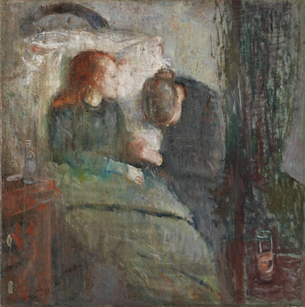
Munch's life was tortuous at best. His female parent died from tuberculous during his fifth Christmas, he caught it seven years afterward and somewhen watched his sis dice from it (Høifødt, 2012, p.7). In Munch'due south own words, "The illness followed me all through my babyhood and youth — the germ of consumption placed its claret-red banner victoriously on the white handkerchief" (Prideaux, 2005, p.66).
Det syke barn (The Sick Child) (Figure 3), is a portrait of Munch's sis Sophie fabricated a decade later. He used a girl called Betzy Nielsen, described as "consumptively cute with a bluish-white pare turning yellow in the blue shadows" as a model for his dying sis in the painting. Described as "consumptively cute with a blue-white skin turning yellow in the blue shadows". He proceeded to paint her while sitting in the wicker chair in which Sophie had died (Prideaux, 2005, p.86).
In this painting and many of Munch'southward subsequent renditions of it, a frail daughter is seen propped up in bed. Her head is turned to face an older adult female who is holding her paw and hanging her head in profound sadness. One tin feel a strong sense of anticipatory grief from the older woman at the thought of losing the kid, who conversely appears to have accepted her fate. In the girl'south path of sight is a long dark pall which could be interpreted as a symbol of her imminent expiry. This painting was referred to as his start sjælemaleri, or "soul paintings" (Prideaux, 2005, p.84).
Munch once said "I paint not what I see but what I saw" (Høifødt, 2012, p.7). Much like Friedrich, Munch's feeling was his law and he used painting as a mode to resolve troubling past events in his life like his sister'due south decease.
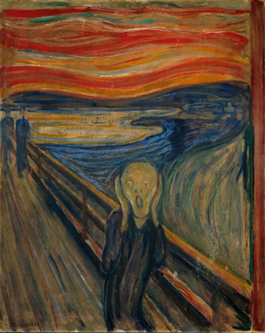
It was also certainly true of his most famous work, Skrik (The Scream) (Figure 4), which was inspired by a memorable evening when he was walking with friends during a sunset. The sky turned "blood red", and "Trembling with feet" he "sensed an infinite scream passing through nature" (Lowis, 2009, p.119).
This painting features a distraught white figure, its hands raised to agree its face, screaming with large open eyes. There is an unforgettably ghastly expression on the face of the individual, who represents Munch during his experience of the dusk.
Through a post-modernistic lens the approach of the expressionism been criticised for its "very hermeneutic model of the inside and the outside" (Harrison & Wood, 2002, p.1049). Theorist Fredric Jameson, in a text well-nigh "the waning of touch on in postmodern culture" said of The Scream, information technology "deconstructs its ain aesthetic of expression, all the while remaining imprisoned within it." (Harrison & Wood, 2002, p.1050).
It would appear that as fine art for fine art's sake waned in the 20th century, audiences became more discerning. He goes on to say, "concepts such as anxiety and breach (and the experiences to which they correspond, as in The Scream) are no longer appropriate in the globe of the postmodern". The purpose behind this painting is no longer relevant, every bit it is self-indulgent. It must be more than accessible by others, according to theorists like Jameson.
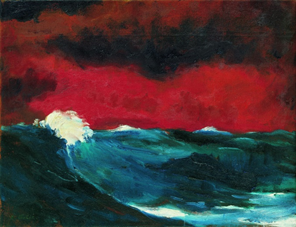
Emil Nolde, another expressionist artist perhaps too influenced by Friedrich (Schmied, 1995, p.40), carried on the expressionistic style of painting into the 20th century. Meer (I) (Figure v), or Sea in English, is 1 of his works produced shortly after the Second Globe State of war concluded.
Nolde was banned from making art past the Nazis, and had more of his works confiscated than any other artist, on the basis that his work was "degenerate" (Staatliche Museen zu Berlin, 2019). All the same he was a fellow member of the Nazi political party, and remained a supporter until the end of the war.
This work features a claret blood-red sky traversed by thick black clouds. Beneath information technology is a restless sea painted in blue and green shades. It seems very appropriate for an firsthand post-war expressionist painting. Perhaps, the red heaven with black clouds signifies an anger or fear apropos the end of the war. The restlessness of the bounding main may represent the restless feelings of Nolde, who had lost his married woman Ada to a middle attack the previous yr. He in fact painted many images of the sea due a memorable crossing of the Kattegat strait in a violent storm in 1910 (Selz, 1963, p.72).
Despite his ban from painting, he notwithstanding managed to quietly paint many watercolours during the state of war which he referred to as "Unpainted Pictures" (Selz, 1963, p.70). Perhaps the demand to express his cocky was too cracking for even the Nazis to totally preclude. The purpose of his art is similar to Friedrich's, in that he painted many seascapes and landscapes because he felt a demand to paint them. Those things held significance for him, in much the way Munch's sis's death was significant to him.
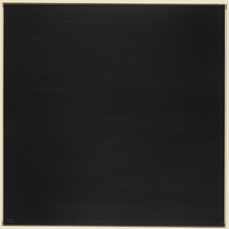
Moving on to the 60s, fine art was becoming yet more abstruse. Pop art was at its height only there were also many avant-garde artists such as Ad Reinhardt producing works that question how far the boundaries of art could be pushed. This pushing of boundaries was nothing new. In the 1910s artists like Marcel Duchamp were doing precisely that. His infamous Fountain, an inverted urinal inscribed with "R. Mutt" in indelible marking, was refused entry and considered not a work of art due its association with actual waste matter by the Guild of Independent Artists (Howarth, 2015).
Reinhardt's Abstract Print (Figure 6) is an almost entirely blackness screen print with a faint white mixed in. The epitome might be seen by theorists like Pater equally lacking in aesthetic quality but may have also been viewed every bit lacking in social purpose by Ruskin. This new form of art that started with the Dadaists goes beyond painting enigmatic landscapes and edgy screaming figures. It is an attempt to push button boundaries of art as a medium.
One of the bug with "art for art's sake" is the tendency for the art market to prosper heavily from these e'er irresolute styles or fashions in art, which are merely stylistic and challenge cipher. Creative person and author Ian Burn believed that this helped to prop upwards capitalism, especially in 1970'southward New York (Harrison & Wood, 2002, p.936). Artists like Salvador Dalí, whose dream-like imagery and style take become very well-known, is an artist that the fine art market clearly loves, every bit his Portrait de Paul Éluard sold for nearly £13.five million in 2011 (Sotheby's, 2011). Still the work is adored its style non for its pregnant.

Burn's argument is based partly on the ideas of theorists similar Ruskin, that art should be used for the social good, which has become a prevalent in the modern era. A lot of artists focus on social or political issues, and those that produce works that do non claiming anything, especially in a troubled country are sometimes seen as upholding the status quo. Artist Christian Jankowski produced a live stream called Kunstmarkt Idiot box (Figure seven), or Art Marketplace Tv set in English, which features two presenters that sell artworks in the style of a teleshopping TV station (Frost, 2013). This was his fashion of critiquing the art market and how it undermines the social value of such fine art.
Lawrence Abu Hamda's After SFX (Figure 8) is a work that is certainly compatible with Ruskin's view of Art. It is based in a large night room with a set of speakers that surround the viewer playing eerie noises, while a large screen displays text explaining that the sounds are those heard by prisoners in a Syrian regime prison.
Hamda is an audio investigator for Amnesty International and Forensic Architecture and this work represents crimes that are heard simply not seen (Tate, 2019). It seeks to inform the audience of the critical piece of work washed by audio investigators Like Hamda while immersing the audience into the frightening experience of the prisoners, which emphasises the urgency of his piece of work. This would be seen by writer Marshall McLuhan as the artist fulfilling their duty past provoking discussions and forcing people to engage with existent world issues (Harrison & Woods, 2002, p.756).
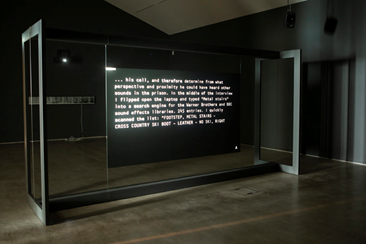
Proponents of aestheticism in the 19th century similar James McNeil Whistler however, would view the work as confounded by "claptrap" (Sutherland, 2014, p.155), and politically and emotionally loaded. To produce that deals with socio-political themes and is quite straight linking to real earth events is to an extent a modern concept, and one that is influenced much past proponents of art with a social purpose, similar Ruskin.
From the analyses of the artworks, one can deduce that the older works past Friedrich, Munch, and Nolde, are nigh expression of emotions, resolving of traumatic events and painting for pleasance. Their piece of work serves the needs of the artists and may exist seen past some equally self-indulgent. Artist Mel Ramsden once complained of "indulgent individual freedom" in artistic practices in 1970s New York. These "insular and tedious" fads that he complained of, were examples of artistic freedom that, equally Ian Burn feared, were subservient to the art market (Harrison & Wood, 2002, p.933).
In the case of Duchamp and Reinhardt, their work is very abstract and is intended to challenge what can exist considered art. Both proponents of aestheticism and socio-political fine art would mayhap dislike this fine art even though information technology has a clear purpose.
For after artists like Jankowski and Hamda, the piece of work serves to enhance sensation of issues in the globe and bring attending to the necessity for socio-political change. Theorists similar Ruskin and McLuhan would take approved of Hamda'due south work, every bit it theoretically improves guild by promoting awareness of social issues.
My own work varies from mere abstract or symbolic expressions of my feelings, like the expressionists, to humorous demonstrations of socio-political issues via exaggeration, similar Jankowski. The German concept of Weltschmerz, a lamenting of the man condition, prominently features in my work, heavily influenced by philosophers Schopenhauer, Wittgenstein and Kierkegaard, and the artists Munch and Nolde.
This view that art should be beautiful or produced entirely without a specific purpose is seen as wasteful in the modern era only in reality it could be but equally valid as the philosophy of Ruskin that art should serve a social purpose. Friedrich believed that "nothing is incidental in a picture" (Friedenthal, 1963, p.33), and Nolde said similarly that the "soul of the painter lives within" paintings (Miesel, 2003, p.37). Both of these phrases are a fashion of saying the same thing, that whatsoever artist will leave parts of their identity in their work, even if completely unintentionally. By this logic, all art automatically expresses the artist'south identity and feelings, and therefore has a purpose from the outset, even if information technology is not the artist's intention. This renders the main question existence investigated somewhat invalid, as perhaps the question should be which purpose is best for Fine art.
Fifty-fifty if art is used past some artists as a form of self-therapy, it is still a valid purpose, and no doubt there are many other people that have shared or similar life experiences to artists similar Munch or Nolde, and therefore the work may strike a chord with them. Sometimes fine art has to exist cocky-indulgent in lodge to project the very complex and specific feelings that an private might have, and those of a similar disposition may observe that work much stronger than piece of work portraying a more than political or social issue. This quickly becomes an argument about minorities versus majorities, and whether or non the individual is about of import or big social groups.
Much of this debate rests on the definition of purpose. If we consider purpose to exist the ultimate effect on the viewer, regardless of the artist'southward intentions, then art could exist considered to have admittedly no purpose by some and exceedingly purposeful by others. If we consider purpose to be the artist's reason for creating the work, whatever that motivation might be, by that definition whatever artwork will automatically have purpose. Fifty-fifty if it is only to bring pleasure, it is still fulfilling a key homo need.
Whatever the purpose or office of art, it is also necessary to define Art. The latter definition of purpose would appear to mark everything one tin create as a work of art, even if it is the carbon dioxide we breathe out. This is somewhat reminiscent of Fluxus creative person Joseph Beuys' view that everyone is an artist (Harrison & Woods, 2002, p.905).
Revisiting the Victorian era, Ruskin believed that fine art and culture could become a replacement for religion after increasing secularisation was inevitable (Cheeke, 2016, p.24). Indeed art theorist André Malraux believed that this has already happened. In Les voix du silence (The Voices of Silence), he said that "modern masters pigment their pictures equally the artists of ancient civilisations carved or painted gods" (Malraux, 1974, p.616). The agenda for Fine art delineated in Art as Therapy by philosopher Alain de Botton and fine art history John Armstrong, is that art should "help mankind in its search for cocky-understanding, empathy, consolation, hope, self-acceptance and fulfilment" (de Botton & Armstrong, 2019, p.230).
Ultimately art has become a new faith, and while there is certainly room for artful beauty and intriguing imagery, in that location is also a firmly established culture of art providing socio-political commentary. It is perhaps non surprising that in a state of war-torn country, for example, an artist might exist seen as a sell-out for producing fine art that is beautiful, yet in a successful country, it may exist a scrap more acceptable. Art reflects greatly the fourth dimension and location in which it was produced, and adapts to the needs of different societies, so the best purpose for fine art is subjective therefore it seems myopic to restrict what art should be.
As discussed before, whatsoever art will accept a purpose by the latter definition, and following the commencement, but certain pieces would accept a purpose. Is this only arguing over semantics and groups arguing past each other? Wittgenstein said that "if a lion could speak, we could non understand him" (Hofstadter, 1980). That is because the lion'due south culture is and so vastly different to ours that, fifty-fifty if we understood the words, they will non mean the same matter as in our linguistic communication. Perhaps the real purpose of art should be to listen to the proverbial lion, forgetting nearly the words and grammar, and accept its vocalisations every bit i of many valid commentaries on life.
Bibliography
a-n, 2019. Lawrence-Abu-Hamdan-Later on-SFX-2018.-Turner-Prize-2019-at-Turner-Contemporary-Margate-2019.-Photo-by-Stuart-Leech-2 — a-n The Artists Information Company. [Online] Available at: https://world wide web.a-n.co.u.k./media/52568843/ [Accessed 29 November 2019].
Artsy, 2018. Caspar David Friedrich | Wanderer above the Bounding main of Fog (ca. 1817) | Artsy. [Online] Available at: https://www.artsy.net/artwork/caspar-david-friedrich-wanderer-above-the-ocean-of-fog [Accessed eighteen November 2018].
Artsy, 2018. Edvard Munch | The Scream (1893) | Artsy. [Online] Bachelor at: https://world wide web.artsy.cyberspace/artwork/edvard-munch-the-scream [Accessed 18 November 2018].
Bohn, B. & Saslow, J.M., 2012. A Companion to Renaissance and Baroque Fine art. Chichester: John Wiley & Sons.
Cheeke, S., 2016. Transfiguration: The Religion of Art in Nineteenth-century Literature Earlier Aestheticism. Oxford: Oxford Academy Press.
Cunningham, 50.S., Reich, J.J. & Fichner-Rathus, L., 2016. Culture and Values: A Survey of the Humanities, Volume two. Boston: Cengage Learning.
de Botton, A. & Armstrong, J., 2019. Art every bit Therapy. London: Phaidon.
Dewald, J., 2004. Europe 1450 to 1789: Absolutism to Coligny. New York: Charles Scribner's Sons.
Encyclopædia Britannica, 1999. Encyclopedia Britannica | Britannica.com. [Online] Available at: https://www.britannica.com/topic/art-for-arts-sake [Accessed 01 November 2019].
Encyclopædia Britannica, 2019. Romanticism | Britannica. [Online] Available at: https://www.britannica.com/fine art/Romanticism [Accessed 28 November 2019].
Friedenthal, R., 1963. Letters of the Great Artists: From Blake to Pollock. New York: Random Firm.
Frost, A., 2013. Art takes on capitalism: but what's at stake? | Art and design | The Guardian. [Online] Available at: https://www.theguardian.com/artanddesign/australia-civilisation-web log/2013/aug/28/art-commercialism-fiscal-report [Accessed x December 2019].
Gaddis, J.L., 2004. The Mural of History: How Historians Map the Past. Oxford: Oxford University Press.
Garbrecht, J., 2008. Emil Nolde: Mein Wunderland von Meer zu Meer (My Wonderland from Sea to Body of water). In Yard. Reuther, ed. Emil Nolde: Mein Wunderland von Meer zu Meer (My Wonderland from Sea to Ocean). Köln: DuMont. pp.17–43.
Gariff, D., Denker, East. & Weller, D.P., 2008. The world'southward nigh influential painters and the artists they inspired. London: A & C Black.
Google Art Project, 2019. Bonaparte Crossing the Grand Saint-Bernard Pass, twenty May 1800 — Jacques Louis David — Google Arts & Culture. [Online] Available at: https://artsandculture.google.com/asset/QwEFHqZhgW6ulw [Accessed 29 November 2019].
Harrison, C. & Wood, P.J., 2002. Fine art in Theory 1900–2000. Oxford: Blackwell.
Hofstadter, D.R., 1980. Gödel, Escher, Bach: An Eternal Golden Braid. London: Penguin.
Høifødt, F., 2012. Edvard Munch. London: Tate.
Howarth, S., 2015. 'Fountain', Marcel Duchamp, 1917, replica 1964 | Tate. [Online] Available at: http://www.tate.org.uk/art/artworks/duchamp-fountain-t07573 [Accessed 25 March 2018].
Jankowski, C., 2008. Kunstmarkt Idiot box / Art Marketplace TV — Christian Jankowski. [Online] Bachelor at: https://christianjankowski.com/works/2008-2/kunstmarkt-telly-fine art-market place-television/ [Accessed 12 December 2019].
Lowis, Chiliad., 2009. 50 Paintings You Should Know. Munich: Prestel.
Malraux, A., 1974. The Voices of Silence. Translated by Southward. Gilbert. St Albans: Paladin.
Miesel, V.H., 2003. Voices of German language Expressionism. New York: Harry Northward. Abrams.
MoMA, 2019. Ad Reinhardt. Abstract Print from New York International. 1966 | MoMA. [Online] Available at: https://www.moma.org/collection/works/65825?clan=portfolios&locale=en&page=1&parent_id=65817&sov_referrer=association [Accessed 14 Dec 2019].
Nasjonalmuseet, 2015. Edvard Munch, Det syke barn — Nasjonalmuseet — Samlingen. [Online] Available at: http://samling.nasjonalmuseet.no/no/object/NG.K.00839 [Accessed 27 November 2019].
Nunokawa, J. & Sickels, A., 2005. Oscar Wilde. Philadelphia: Chelsea House Publishers.
Pater, Westward., 1928. The Renaissance: Studies In The Fine art And Verse. London: Jonathan Cape.
Prideaux, S., 2005. Edvard Munch: Behind the Scream. New Haven: Yale Academy Press.
Ratcliffe, S., 2011. Oxford Treasury of Sayings and Quotations. Oxford: Oxford Academy Press.
Ruskin, J., 1996. Lectures on Fine art. New York: Allworth Press.
Schmied, Westward., 1995. Caspar David Friedrich. New York: H.North. Abrams.
Selz, P.H., 1963. Emil Nolde. New York: Doubleday.
Sotheby's, 2011. dalí, salvado ||| impressionist & modernistic art ||| sotheby's l11001lot5xjx9en. [Online] Available at: http://www.sothebys.com/en/auctions/ecatalogue/2011/looking-closely-l11001/lot.seven.html [Accessed 11 December 2019].
Staatliche Museen zu Berlin, 2019. Emil Nolde. A German Legend. The Artist during the Nazi Regime. [Online] Available at: https://www.smb.museum/en/exhibitions/detail/emil-nolde-a-high german-legend-the-artist-during-the-nazi-government.html [Accessed 25 Nov 2019].
Sutherland, D.E., 2014. Whistler: A Life for Art's Sake. New Haven: Yale University Press.
Tate, 2019. Lawrence Abu Hamdan: Subsequently SFX — Operation at Tate Modern | Tate. [Online] Available at: https://www.tate.org.uk/whats-on/tate-mod/performance/lawrence-abu-hamdan-after-sfx [Accessed one November 2019].
Wiedmann, A.K., 1986. Romantic Art Theories. Newport: Gresham Books.
lollistakinquanded1938.blogspot.com
Source: https://medium.com/@susanday_25940/an-analysis-of-the-function-of-art-and-whether-it-should-have-a-purpose-6a8b14571479
0 Response to "Ls Andre Malraux the Voices of Silence Art History or Philosophy"
Post a Comment